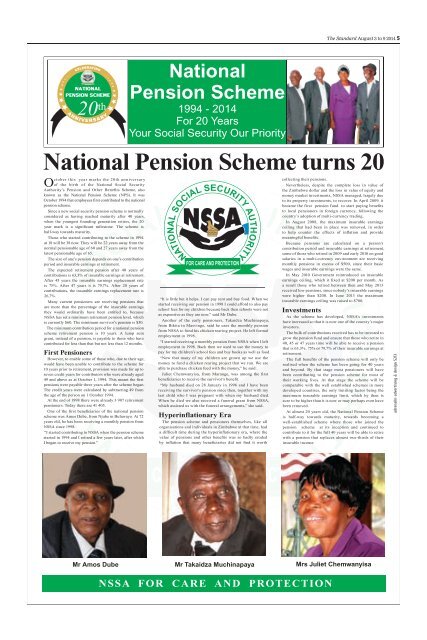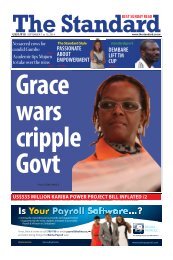You also want an ePaper? Increase the reach of your titles
YUMPU automatically turns print PDFs into web optimized ePapers that Google loves.
<strong>The</strong> <strong>Standard</strong> August 3 to 9 2014 5<br />
National<br />
Pension Scheme<br />
1994 - 2014<br />
For 20 Years<br />
Your Social Security Our Priority<br />
October this year marks the 20th anniversary<br />
of the birth of the National Social Security<br />
Authority’s Pension and Other Benefits Scheme, also<br />
known as the National Pension Scheme (NPS). It was<br />
October 1994 that employees first contributed to the national<br />
pension scheme.<br />
Since a new social security pension scheme is normally<br />
considered as having reached maturity after 40 years,<br />
when the youngest founding generation retires, the 20<br />
year mark is a significant milestone. <strong>The</strong> scheme is<br />
half-way towards maturity.<br />
Those who started contributing to the scheme in 1994<br />
at 18 will be 38 now. <strong>The</strong>y will be 22 years away from the<br />
normal pensionable age of 60 and 27 years away from the<br />
latest pensionable age of 65.<br />
<strong>The</strong> size of one’s pension depends on one’s contribution<br />
period and insurable earnings at retirement.<br />
<strong>The</strong> expected retirement pension after 40 years of<br />
contributions is 63,3% of insurable earnings at retirement.<br />
After 45 years the insurable earnings replacement rate<br />
is 75%. After 47 years it is 79,7%. After 20 years of<br />
contributions, the insurable earnings replacement rate is<br />
26,7%.<br />
Many current pensioners are receiving pensions that<br />
are more than the percentage of the insurable earnings<br />
they would ordinarily have been entitled to, because<br />
NSSA has set a minimum retirement pension level, which<br />
is currently $60. <strong>The</strong> minimum survivor’s pension is $30.<br />
<strong>The</strong> minimum contribution period for a national pension<br />
scheme retirement pension is 10 years. A lump sum<br />
grant, instead of a pension, is payable to those who have<br />
contributed for less than that but not less than 12 months.<br />
First Pensioners<br />
However, to enable some of those who, due to their age,<br />
would have been unable to contribute to the scheme for<br />
10 years prior to retirement, provision was made for up to<br />
seven credit years for contributors who were already aged<br />
49 and above as at October 1, 1994. This meant the first<br />
pensions were payable three years after the scheme began.<br />
<strong>The</strong> credit years were calculated by subtracting 49 from<br />
the age of the person on 1 October 1994.<br />
At the end of 1998 there were already 3 907 retirement<br />
pensioners. Today there are 41 405.<br />
One of the first beneficiaries of the national pension<br />
scheme was Amos Dube, from Njube in Bulawayo. At 72<br />
years old, he has been receiving a monthly pension from<br />
NSSA since 1998.<br />
“I started contributing to NSSA when the pension scheme<br />
started in 1994 and I retired a few years later, after which<br />
I began to receive my pension.”<br />
National Pension Scheme turns 20<br />
“It is little but it helps. I can pay rent and buy food. When we<br />
started receiving our pension in 1998 I could afford to also pay<br />
school fees for my children because back then schools were not<br />
as expensive as they are now,” said Mr Dube.<br />
Another of the early pensioners, Takaidza Muchinapaya,<br />
from Bikita in Masvingo, said he uses the monthly pension<br />
from NSSA to fund his chicken rearing project. He left formal<br />
employment in 1998.<br />
“I started receiving a monthly pension from NSSA when I left<br />
employment in 1998. Back then we used to use the money to<br />
pay for my children’s school fees and buy books as well as food.<br />
“Now that many of my children are grown up we use the<br />
money to fund a chicken rearing project that we run. We are<br />
able to purchase chicken feed with the money,” he said.<br />
Juliet Chemwanyisa, from Marange, was among the first<br />
beneficiaries to receive the survivor’s benefit.<br />
“My husband died on 28 January in 1996 and I have been<br />
receiving the survivor’s pension since then, together with my<br />
last child who I was pregnant with when my husband died.<br />
When he died we also received a funeral grant from NSSA,<br />
which assisted us with the funeral arrangements,” she said.<br />
Hyperinflationary Era<br />
<strong>The</strong> pension scheme and pensioners themselves, like all<br />
organisations and individuals in Zimbabwe at that time, had<br />
a difficult time during the hyperinflationary era, where the<br />
value of pensions and other benefits was so badly eroded<br />
by inflation that many beneficiaries did not find it worth<br />
collecting their pensions.<br />
Nevertheless, despite the complete loss in value of<br />
the Zimbabwe dollar and the loss in value of equity and<br />
money market investments, NSSA managed, largely due<br />
to its property investments, to recover. In April 2009, it<br />
became the first pension fund to start paying benefits<br />
to local pensioners in foreign currency, following the<br />
country’s adoption of multi-currency trading.<br />
In August 2008, the maximum insurable earnings<br />
ceiling that had been in place was removed, in order<br />
to help counter the effects of inflation and provide<br />
meaningful benefits.<br />
Because pensions are calculated on a person’s<br />
contribution period and insurable earnings at retirement,<br />
some of those who retired in 2009 and early 2010 on good<br />
salaries in a multi-currency environment are receiving<br />
monthly pensions in excess of $500, since their basic<br />
wages and insurable earnings were the same.<br />
In May 2010 Government reintroduced an insurable<br />
earnings ceiling, which it fixed at $200 per month. As<br />
a result those who retired between then and May 2013<br />
received low pensions, since nobody’s insurable earnings<br />
were higher than $200. In June 2013 the maximum<br />
insurable earnings ceiling was raised to $700.<br />
Investments<br />
As the scheme has developed, NSSA’s investments<br />
have increased so that it is now one of the country’s major<br />
investors.<br />
<strong>The</strong> bulk of contributions received has to be invested to<br />
grow the pension fund and ensure that those who retire in<br />
40, 45 or 47 years time will be able to receive a pension<br />
that is 63,3%, 75% or 79,7% of their insurable earnings at<br />
retirement.<br />
<strong>The</strong> full benefits of the pension scheme will only be<br />
realised when the scheme has been going for 40 years<br />
and beyond. By that stage most pensioners will have<br />
been contributing to the pension scheme for most of<br />
their working lives. At that stage the scheme will be<br />
comparable with the well established schemes in more<br />
developed countries, the only limiting factor being the<br />
maximum insurable earnings limit, which by then is<br />
sure to be higher than it is now or may perhaps even have<br />
been removed.<br />
At almost 20 years old, the National Pension Scheme<br />
is half-way towards maturity, towards becoming a<br />
well-established scheme where those who joined the<br />
pension scheme at its inception and continued to<br />
contribute to it for the full 40 years will be able to retire<br />
with a pension that replaces almost two-thirds of their<br />
insurable income.<br />
adrenalin advertising & design 5213<br />
Mr Amos Dube Mr Takaidza Muchinapaya Mrs Juliet Chemwanyisa<br />
NSSA FOR CARE AND PROTECTION


















